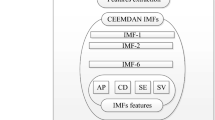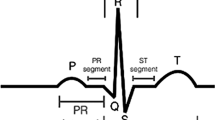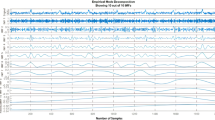Abstract
In the Internet of Medical Things (IoMT), medical devices and applications are linked via networking to create a healthcare data framework. In the IoMT environment, a healthcare tracking framework is required to detect health abnormalities on a proper basis and prescribe treatments based on the data obtained from wearable sensors. In the IoMT platform, an Electrocardiogram (ECG) helps to analyze the electrical function of the heart in a simplified and comfortable way. ECG monitoring is used to diagnose heart diseases, such as arrhythmias. ECG signal analysis automatically detect and classify life-threatening arrhythmias associated with various cardiac situations. Arrhythmia diagnosis and classification can be misinterpreted when ECG signals are corrupted with different noises. To overcome such interpretation Variance Approximation and Probabilistic Decomposition Noise Removal method (VA-PDNR) has been developed to denoise the ECG signal for arrhythmia detection and classification. VA has been used to reduce high-frequency noise in ECG signals by controlling the operational variables to minimize noise variation. Furthermore, PDNR breaks up the power line interference into different mode parameters and remove noise by utilizing Linear Quadratic Estimation. The dimension-reduction analysis aims to remove redundancies and verify characteristic textural characteristics. All such hybrid features are blended and fed to the Artificial Neural Network (ANN) for Arrhythmia classification. Improves the signal-to-noise ratio (SNR) to 34.55 dB, the accuracy to 98.99 per cent, and the mean square error rate. VA-PDNR method is estimated using ECG signals collected from MIT-BIH Arrhythmia dataset and improves Signal-to-Noise Ratio (SNR) to 34.55 dB, accuracy to 98.99%, and lesser mean square error (MSE) rate.














Similar content being viewed by others
Change history
27 March 2022
The original online version of this article was revised: The corresponding author information was corrected.
References
Adeniyi, E.A., Ogundokun, R.O., & Awotunde, J.B. (2021). IoMT-based wearable body sensors network healthcare monitoring system. In InIoT in healthcare and ambient assisted living. (Springer, Singapore, pp. 103–121).
Awotunde, J.B., Ogundokun, R.O., & Misra, S. (2021). Cloud and IoMT-based big data analytics system during COVID-19 pandemic. In Efficient data handling for massive internet of medical things. (Springer, Cham, pp. 181–201).
Sethuraman, S.C., Kompally, P., Mohanty, S.P., & Choppali, U. (2021), MyWear: A novel smart garment for automatic continuous vital monitoring. IEEE Transactions on Consumer Electronics.
Abdel-Basset, M., Chang, V., & Nabeeh, N. A. (2021). An intelligent framework using disruptive technologies for COVID-19 analysis. Technological Forecasting and Social Change, 163, 120431.
Awotunde, J.B., Folorunso, S.O., Bhoi, A.K., Adebayo, P.O., & Ijaz. M.F. (2021). Disease diagnosis system for IoT-based wearable body sensors with a machine learning algorithm. In Hybrid Artificial Intelligence and IoT in Healthcare (pp. 201–222). Springer, Singapore
Ru, L., Zhang, B., Duan, J., Ru, G., Sharma, A., Dhiman, G., Gaba, G. S., Jaha, E. S., & Masud, M. (2021 May). A Detailed research on human health monitoring system based on internet of things. Wireless Communications and Mobile Computing., 15, 2021.
Abdulrahman, L.M., Zeebaree, S.R., Kak, S.F., Sadeeq, M.A., Adel, A.Z., Salim, B.W., & Sharif. K.H. (2021). State of the art for smart gateways issues and modification. Asian Journal of Research in Computer Science.:1–3.
El Zouka, H. A., & Hosni, M. M. (2021). Secure IoT communications for smart healthcare monitoring systems. Internet of Things, 13, 100036.
Lakshmi, G.J., Ghonge, M., & Obaid, A.J. (2021). Cloud based IoT Smart Healthcare System for Remote Patient Monitoring. EAI Endorsed Transactions on Pervasive Health and Technology:e4.
Zhao, M., Wang, M., Zhang, J., Ye, J., Xu, Y., Wang, Z., Ye, D., Liu, J., & Wan, J. (2020). Advances in the relationship between coronavirus infection and cardiovascular diseases. Biomedicine & Pharmacotherapy, 127, 110230.
Webster, G., Aburawi, E. H., Chaix, M. A., Chandler, S., Foo, R., Islam, A. M., Kammeraad, J. A., Rioux, J. D., Al-Gazali, L., Sayeed, M. Z., & Xiao, T. (2021). Life-threatening arrhythmias with autosomal recessive TECRL variants. EP Europace., 23(5), 781–788.
Yadav, S. S., & Jadhav, S. M. (2021). Detection of common risk factors for diagnosis of cardiac arrhythmia using machine learning algorithm. Expert Systems with Applications, 163, 113807.
Mazaheri, V., & Khodadadi, H. (2020). Heart arrhythmia diagnosis based on the combination of morphological, frequency and nonlinear features of ECG signals and metaheuristic feature selection algorithm. Expert Systems with Applications, 161, 113697.
Scudder, M.R., Jennings, J.R., DuPont, C.M., Lockwood, K.G., Gadagkar, S.H., Best, B., Jasti, S.P., & Gianaros. P.J. (2021). Dual impedance cardiography: An inexpensive and reliable method to assess arterial stiffness. Psychophysiology e13772.
Nurmaini, S., Tondas, A. E., Darmawahyuni, A., Rachmatullah, M. N., Partan, R. U., Firdaus, F., Tutuko, B., Pratiwi, F., Juliano, A. H., & Khoirani, R. (2020). Robust detection of atrial fibrillation from short-term electrocardiogram using convolutional neural networks. Future Generation Computer Systems., 113, 304–317.
Abdollahpoor, R., & Lotfivand, N. (2020). Fully Adaptive Denoising of ECG Signals Using Empirical Mode Decomposition with the Modified Indirect Subtraction and the Adaptive Window Techniques. Circuits, Systems, and Signal Processing., 39(8), 4021–4046.
Zhang, H., & Li, Z. (2021). Automatic detection for multi-labelled cardiac arrhythmia based on frame blocking pre-processing and Residual Networks. Frontiers in cardiovascular medicine., 8, 135.
Zulfiqar, R., Majeed, F., Irfan, R., Rauf, H.T., Benkhelifa, E., Belkacem, A.N. (2021). Abnormal Respiratory Sounds Classification Using Deep CNN Through Artificial Noise Addition. Frontiers in Medicine. 8.
Prashar, N., Sood, M., & Jain, S. (2021). Design and implementation of a robust noise removal system in ECG signals using dual-tree complex wavelet transform. Biomedical Signal Processing and Control, 63, 102212.
Chatterjee, S., Thakur, R. S., Yadav, R. N., Gupta, L., & Raghuvanshi, D. K. (2020). Review of noise removal techniques in ECG signals. IET Signal Processing., 14(9), 569–590.
Chakravorti, T., & Satyanarayana, P. (2020). Non linear system identification using kernel-based exponentially extended random vector functional link network. Applied Soft Computing, 89, 106117.
Zhang, T., Ding, B., Zhao, X., Liu, G., & Pang, Z. (2021). LearningADD: Machine learning-based acoustic defect detection in factory automation. Journal of Manufacturing Systems., 60, 48–58.
Gao, J., Zhang, H., Lu, P., & Wang, Z. (2019). An effective LSTM recurrent network to detect arrhythmia on an imbalanced ECG dataset. Journal of healthcare engineering.
Zhang, D., Wang, S., Li, F., Wang, J., Sangaiah, A. K., Sheng, V. S., & Ding, X. (2019). An ECG signal denoising approach based on wavelet energy and sub-band smoothing filter. Applied Sciences, 9(22), 4968.
Satija, U., Ramkumar, B., & Manikandan, M. S. (2018). A new automated signal quality-aware ECG beat classification method for unsupervised ECG diagnosis environments. IEEE Sensors Journal, 19(1), 277–286.
Marinho, L. B., de MM Nascimento, N., Souza, J. W. M., Gurgel, M. V., Rebouças Filho, P. P., & de Albuquerque, V. H. C. (2019). A novel electrocardiogram feature extraction approach for cardiac arrhythmia classification. Future Generation Computer Systems, 97, 564–577.
Tuncer, T., Dogan, S., Pławiak, P., & Acharya, U. R. (2019). Automated arrhythmia detection using novel hexadecimal local pattern and multilevel wavelet transform with ECG signals. Knowledge-Based Systems, 186, 104923.
Tian, X., Li, Y., Zhou, H., Li, X., Chen, L., & Zhang, X. (2016). Electrocardiogram signal denoising using extreme-point symmetric mode decomposition and nonlocal means. Sensors, 16(10), 1584.
Zhang, J., Liu, A., Gao, M., Chen, X., Zhang, X., & Chen, X. (2020). ECG-based multi-class arrhythmia detection using Spatio-temporal attention-based convolutional recurrent neural network. Artificial Intelligence in Medicine, 106, 101856.
Iqbal, U., Wah, T. Y., ur Rehman, M. H., Mujtaba, G., Imran, M., & Shoaib, M. (2018). Deep deterministic learning for pattern recognition of different cardiac diseases through the internet of medical things. Journal of medical systems, 42(12), 1–25.
Moody, G., & Mark, R. (2001). The impact of the MIT-BIH Arrhythmia Database. IEEE Engineering in Medicine and Biology Magazine, 20(3), 45–50.
Moody, G., Muldrow, W., & Mark, R. (1984). A noise stress test for arrhythmia detectors, in: Computers in Cardiology 1984 IEEE, pp. 381–384.
Acknowledgements
We would like to thank Department of Science and Technology (DST), SEED Division for Funding this project.
Author information
Authors and Affiliations
Contributions
C. Prajitha: Conception and design of study. K.P.Sridhar: Acquisition of data. S. Baskar: Analysis and/or interpretation of data.
Corresponding author
Ethics declarations
Conflict of interest
The authors declare that they have no conflict of interest.
Ethical approval
This article does not contain any studies with human participants or animals performed by any of the authors.
Additional information
Publisher's Note
Springer Nature remains neutral with regard to jurisdictional claims in published maps and institutional affiliations.
Rights and permissions
About this article
Cite this article
Prajitha, C., Sridhar, K.P. & Baskar, S. Variance Approximation and Probabilistic Decomposition Noise Removal Framework for Arrhythmia Detection and Classification on Internet of Medical Things Environment. Wireless Pers Commun 125, 965–985 (2022). https://doi.org/10.1007/s11277-022-09585-2
Accepted:
Published:
Issue Date:
DOI: https://doi.org/10.1007/s11277-022-09585-2




